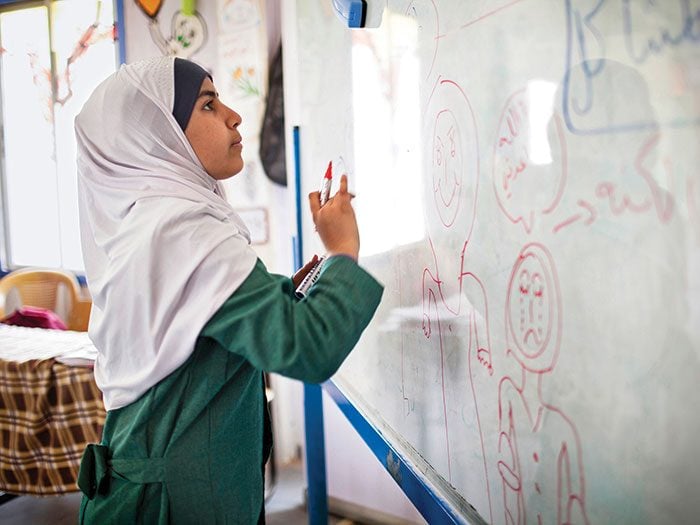
15 Minutes with Jessi Cruickshank
Reader’s Digest: What has surprised you as host of Canada’s Smartest Person?
Jessi Cruickshank: The people who have demonstrated the most well rounded intelligence are ones most people sadly don’t usually expect – a truck driver, a football player or a cheerleader. When I signed up for this show, I assumed that it would be physicists, astronauts and teachers. I’ve been really blown away by how smart Canadians are in all different fields.
How do you think you’d do if you were a contestant?
I’d try every challenge and it’d be embarrassing. But there are certain categories that I’m good at, like the social intelligence category. If I wasn’t, I’d probably be terrible at my job. And I’m good at the linguistic category – I was an English major so at least I got my college money’s worth.
You divide your time between Toronto and Los Angeles. What do you miss the most about Canada when you’re over there?
I feel more and more proud to be Canadian, and I’m more vocal about that. But I really miss the sense of national pride. Look at the Raptors, and the way our country came together [last season] in a way that only Canada can do. And when it comes to the Olympics, we’re not China or the U.S. We don’t have hundreds of thousands of athletes. But we do have these incredible outliers who’ve worked their whole lives to get where they are, and we root for them and hold them on the pedestals that they deserve to be on. It’s just such a unifying thing to feel that Canadian pride.
You’re also the co-host of CBC’s new series, The Goods. Do you think daytime television will be a learning process for you?
I learn every single day in my job. I know when I have a great interview, a terrible interview and when I wear or say something stupid. I think one good thing is that a Canadian audience has grown up with me. People know me, and know my flaws and imperfections. They know that I’m not that glossy. I make mistakes and I can be real. And I’m doing this new daytime show, which is obviously going to be a huge learning curve as well.
How would you convince people who haven’t seen Canada’s Smartest Person to start watching it?
The show is not trivia. We’re not testing book smarts. It’s not Jeopardy or a quiz show. It really is a fun, gigantic, live television event. Anything can happen every single episode. You see people that you’ll root for that are from your hometown or who do the same thing you do. As a viewer, you can’t help but get behind that.
Canada’s Smartest Person returns for its third season on Sundays at 8 p.m. (8:30 NT), beginning on Nov. 13.

Got a catchy caption for this photo?
Lois Bertram of Toronto shares an adorable pic of Rylee McKenna, who is the daughter of a family friend, reluctantly having her photo taken at Christmas several years ago.
Send your funny one-liners for this photo in the comments section below or through Our Canada‘s submissions site (please identify it as an entry for Caption Corner)!
Check out more Caption Corner challenges.
Don’t miss out-sign up for the Our Canada e-newsletter!

Water stunt aids disease research
Medicine In the summer of 2014, the craze of nominating friends to get a freezing cold soaking in the so-called Ice Bucket Challenge swept the world. Celebrities such as David Beckham (pictured) took part. The idea was to promote awareness of Motor Neurone Disease (MND) and encourage donations for research into the condition, which attacks the nerves in the brain and spinal cord.
At the time, some dismissed the Challenge as just a stunt, yet it raised more than $100m, and now a research project in the Netherlands funded by the campaign has identified a new gene associated with the disease that could lead to new treatment possibilities.
Dutch entrepreneur Bernard Muller, who suffers from MND, founded the project with the aim of unravelling the genetic basis of the disease. He thinks the Ice Bucket Challenge campaign was crucial.
“The funding has helped us with research, but it has also had a profound effect on awareness,” he says. “I’m incredibly pleased with the discovery of the gene adding another step towards our ultimate goal of eradicating this disease.”
Dutch prisons are closing
Crime The Netherlands has a population of 17 million people but only 11,600 of them are in jail-a tiny proportion compared with most other countries. Prison numbers have been falling since 2004 and, as
a result, the country’s prisons have been closing: eight in 2009, another 19 in 2014, and now another five are set to follow.
According to Ard van der Steur, Dutch minister of security and justice, the reasons behind the phenomenon are twofold: shorter sentences and a decline in serious crimes.
But what to do with the empty prisons? The Netherlands has begun “leasing” them as prisons to other countries, such as Belgium and Norway. One former prison in the Dutch town of Roermond has even been turned into a hotel.
Locking up greenhouse gas
Environment Scientists in Iceland have found a way to turn carbon dioxide into salt-like crystals in a project dubbed “Carbfix”. At the Hellisheidi geothermal plant, researchers dissolve the gas in water before injecting it into basalt rock, which chemically reacts with it to create a mineral in a matter of months. The process could become an important addition to methods of reducing greenhouse gases.

Fighting early marriage When 11-year-old Syrian Omaima arrived in Jordan’s sprawling Za’atari refugee camp in 2012, she began to find that new friends of her own age were disappearing-to arranged marriages. Although the practice is not common in Syria, it has become more widespread in the camps as some families seek to ease their financial responsibilities by marrying off their daughters.
Omaima now does all she can to stop the same fate befalling other girls, encouraging classmates to share information on the practice with their parents and working as a volunteer with a child protection group. She says she hopes to get married herself one day. “But only on my terms, after I’ve finished my education and been to university.”
Sources: Medicine: The Guardian, 27 July 2016. Crime: Daily Telegraph, 22 March 2016. Environment: National Geographic, 9 June 2016. Heroes: UNHCR Tracks, 12 April 2016

Northern Fun: Fort Smith, N.W.T.
My husband, Ken, and I have lived in Fort Smith for the past five years. Ken is the manager of a power plant and I am a substitute teacher. We moved to Fort Smith after ten years in the Cayman Islands, where I taught at Cayman International School.
Prior to Cayman, we lived in Fort Good Hope, N.W.T., for eight years, so we were very familiar with long winters and temperatures of -40°C. We both felt that it was time to move back to Canada to be close to our son, Tyler, who attends school at the Southern Alberta Institute of Technology in Calgary.
Fort Smith, which is 1,600 kilometres north of Calgary and hundreds of kilometres from the nearest Tim Hortons, is a quiet town with a population of just over 2,000. In less than a ten-minute walk from our house, we can be at Slave River, watching the pelicans playing and fishing in the rapids. The ice has barely broken up in the river when the pelicans return each year from their migration to warmer coastal areas.
A short drive out of town and we are likely to spot a black bear or a few bison, especially in nearby Wood Buffalo National Park. Other days, we’ll see a lynx or several sandhill cranes.
I loved living in the Cayman Islands but I missed the seasons. In winter, I enjoy cross-country skiing and seeing the northern lights. I love spring in the north because we can spot the first crocuses in early May when there are still patches of snow on the ground.
During the spring and summer months we golf, bike and go for long walks. I also love the fall and seeing the leaves change colours. Fort Smith is a perfect place for getting outdoors—with a camera, of course!
It was a big transition moving from Cayman to Fort Smith, but it’s wonderful to be able to come home for lunch every day and never worry about the traffic, especially as there are no cruise ships in port for the day. In fact, we don’t even have any traffic lights here!
It was great living on an island with parrots, iguanas and turtles, but it’s pretty awesome to see pelicans, bears and foxes regularly. Now, if we could just do something about those mosquitoes!